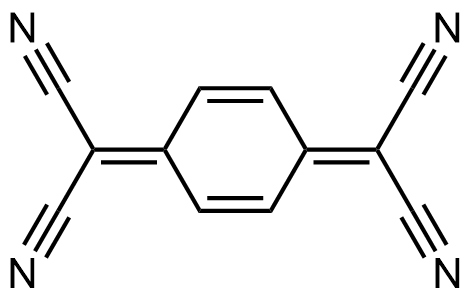The content on our website is provided solely for general informational purposes. It should not be considered, nor is it intended to provide advice or recommendations for the purchase, sale, or trade of any products or services. Importantly, the information presented does not constitute an offer to sell or a solicitation of an offer to buy any product.
Please be aware that the availability of our products may vary across different markets due to regulatory restrictions or other considerations. Consequently, not all products or services may be available in your region or country. For specific inquiries regarding the availability and pricing of any product, please contact us at sales@noctiluca.eu.
General information
-
Name:
TCNQ
-
Full name:
7,7,8,8-Tetracyanoquinodimethane
-
CAS number:
1518-16-7
-
Chemical formula:
C12H4N4
-
Molecular weight:
204.19 g/mol
-
Absorption:
N/A
-
Photoluminescence:
λmax = 259 nm, 404 nm in DCM
-
HOMO/LUMO:
N/A for HOMO level, LUMO = 4.5 eV
-
Synonyms:
(2,5-Cyclohexadiene-1,4-diylidene)-dimalononitrile, 2,2'-(2,5-Cyclohexadiene-1,4-diylidene)bismalononitrile
-
Classification:
Organic light-emitting diodes, Light-emitting diodes, Electron acceptor, Hole injection layer materials (HIL), Hole transport layer materials (HTL), Polymer solar cells, Organic field-effect transistor (OFET)
-
Purity:
Sublimed: >99%
-
Melting point:
289 °C
-
Appearance:
Dark yellow to brown powder/crystals
TCNQ: Advanced Electron Acceptor for OLED and Solar Cell Applications
7,7,8,8-Tetracyanoquinodimethane (TCNQ), with CAS number 1518-16-7, stands at the forefront of material science for its remarkable role as an electron acceptor in various electronic and photonic devices. Its molecular formula, C12H4N4, signifies its unique composition that makes it integral to the functioning of Organic Light-Emitting Diodes (OLEDs), Light-Emitting Diodes (LEDs), and Polymer Solar Cells. With a sublimation purity of over 99%, TCNQ is poised to revolutionize the efficiency and performance of hole injection and transport layers in OLEDs, alongside its critical function in organic field-effect transistors (OFETs).
The Molecular Structure and Properties of TCNQ
TCNQ’s molecular architecture is characterized by its tetracyanoquinodimethane skeleton, which facilitates its function as a potent electron acceptor. This configuration contributes to a LUMO energy level of 4.5 eV, underscoring its efficacy in accepting electrons and enhancing charge transfer processes. The absence of a defined HOMO level further highlights its specificity in electron acceptance, making it a critical component in the development of advanced electronic materials. TCNQ’s structural attributes are essential for its role in improving conductivity and stability in a broad spectrum of electronic applications.
Key Features of TCNQ
- Exceptional Electron Acceptance: TCNQ stands at the forefront of materials science as a premier electron acceptor, distinguished by its unparalleled capacity to facilitate efficient charge transfer mechanisms. This property is crucial in optimizing the operational efficiency of a wide range of electronic devices, particularly in enhancing the performance of Organic Light-Emitting Diodes (OLEDs) and polymer solar cells. The incorporation of TCNQ into these devices significantly reduces energy loss during electron transfer processes, leading to improved device efficiency and reduced power consumption. As a result, TCNQ is a key material in the development of next-generation high-performance OLED displays and solar energy harvesting systems, reinforcing Noctiluca’s reputation as a leading provider of advanced OLED and photovoltaic materials.
- Versatility in Application: TCNQ’s exceptional adaptability across a spectrum of electronic and photonic technologies highlights its critical importance in the field of organic electronics. Its application extends beyond traditional OLEDs and LEDs to include Organic Field-Effect Transistors (OFETs) and polymer solar cells, marking it as a versatile material that supports a wide array of advanced organic electronic configurations. This versatility enables the development of devices with enhanced performance characteristics, including higher brightness, greater energy efficiency, and improved stability. Furthermore, TCNQ’s ability to be seamlessly integrated into various electronic architectures underscores Noctiluca’s commitment to driving innovation in the OLED materials market, as well as in the broader context of organic electronics. Through the provision of TCNQ and related materials, Noctiluca continues to support the evolution of the industry towards more efficient, reliable, and versatile electronic devices.
- Enhanced Stability in Electronic Devices: TCNQ’s chemical stability is a cornerstone feature, significantly contributing to the longevity and reliability of electronic devices. Its robust molecular structure ensures minimal degradation over time, even under the high-stress conditions common in OLED operation and solar cell applications. This stability is pivotal for maintaining consistent device performance, reducing the need for frequent replacements or repairs, and ultimately leading to more sustainable electronic solutions. By incorporating TCNQ, Noctiluca supports the industry’s move towards durable and eco-friendly technology advancements, reinforcing our role as a key supplier of innovative materials.
The Role of TCNQ in Advanced OLEDs
The incorporation of TCNQ in OLED technology as an advanced electron acceptor significantly propels the field forward, enhancing both the efficiency and stability of these devices. By facilitating superior charge transport, TCNQ optimizes electron flow, a critical factor for achieving uniform light emission and enhancing the luminance of OLED displays. This optimization contributes to the development of energy-efficient OLED materials, directly impacting the reduction of power consumption and extending the operational life of OLED technologies. Additionally, TCNQ’s role in improving the durability of transport layer materials ensures that OLED devices offer sustainable performance over time. Noctiluca’s dedication to integrating TCNQ into next-generation OLED applications underscores our commitment to advancing OLED technology, marrying the goals of sustainability with cutting-edge display performance. Through the strategic use of TCNQ, we continue to support the industry’s progression towards more efficient, reliable, and environmentally friendly electronic displays.
Conclusion
TCNQ highlights Noctiluca’s forefront position in the innovation of material science, specifically within the OLED and organic electronics sectors. Our expertise in the meticulous synthesis and provision of high-quality TCNQ, allied with our extensive suite of contract research organization (CRO) services, establishes our leadership in this specialized field. The adoption of advanced materials such as TCNQ empowers us to extend the technological boundaries, ensuring our partners attain outstanding achievements in device performance and ecological sustainability. As a dedicated CRO company, we are focused on advancing the development and supply of premier OLED materials, driving the industry towards the next generation of innovative, efficient, and environmentally responsible electronic devices.
